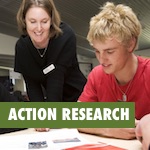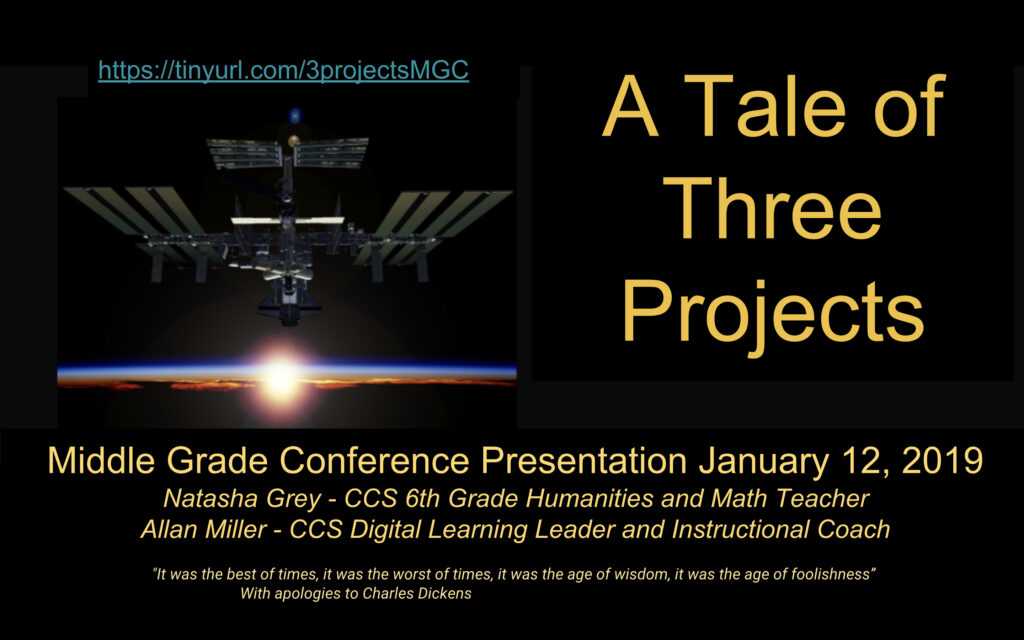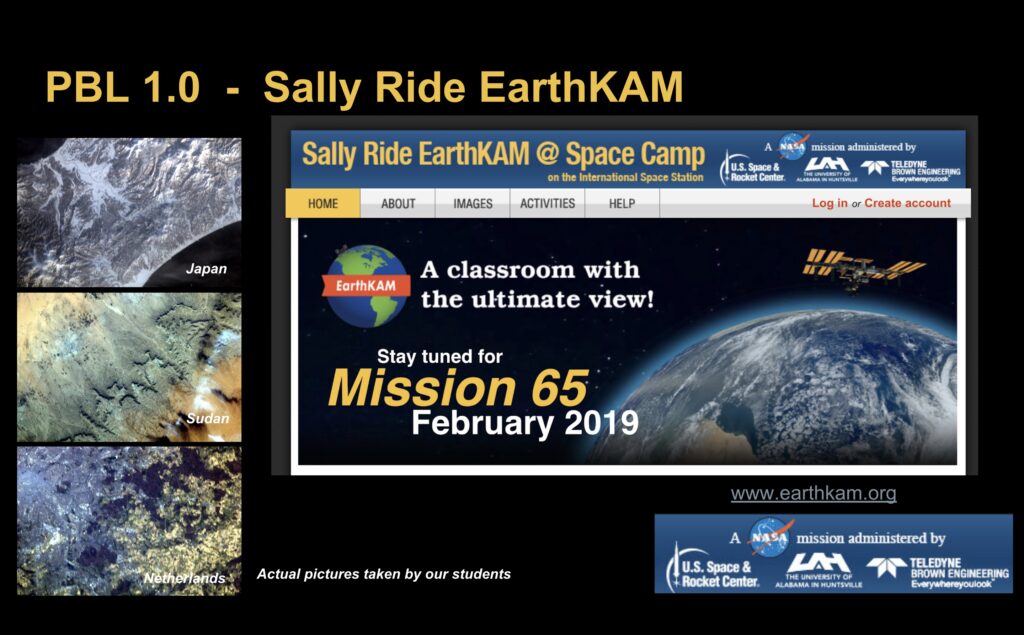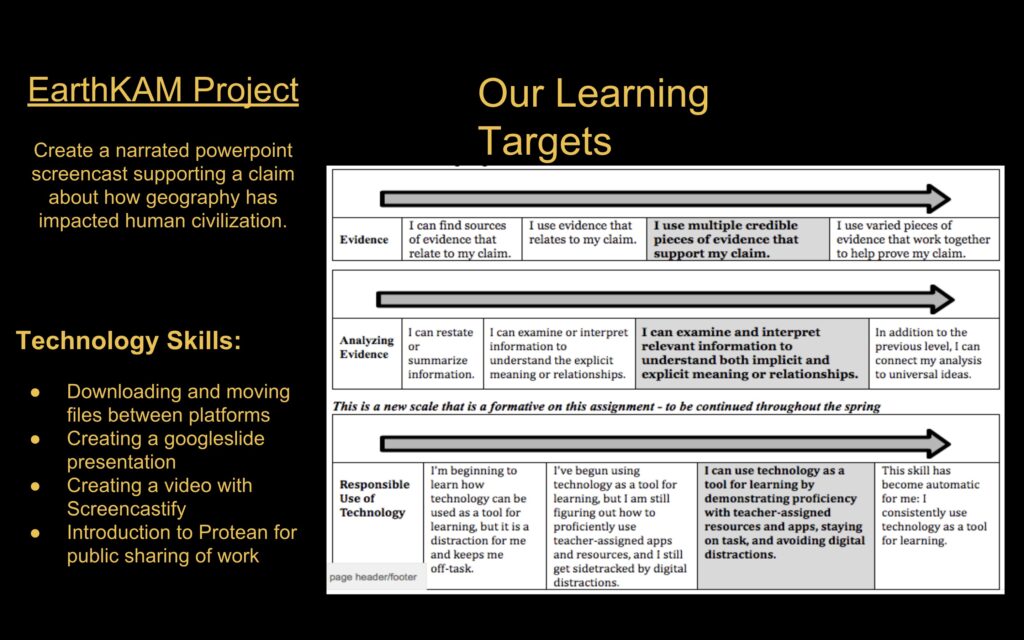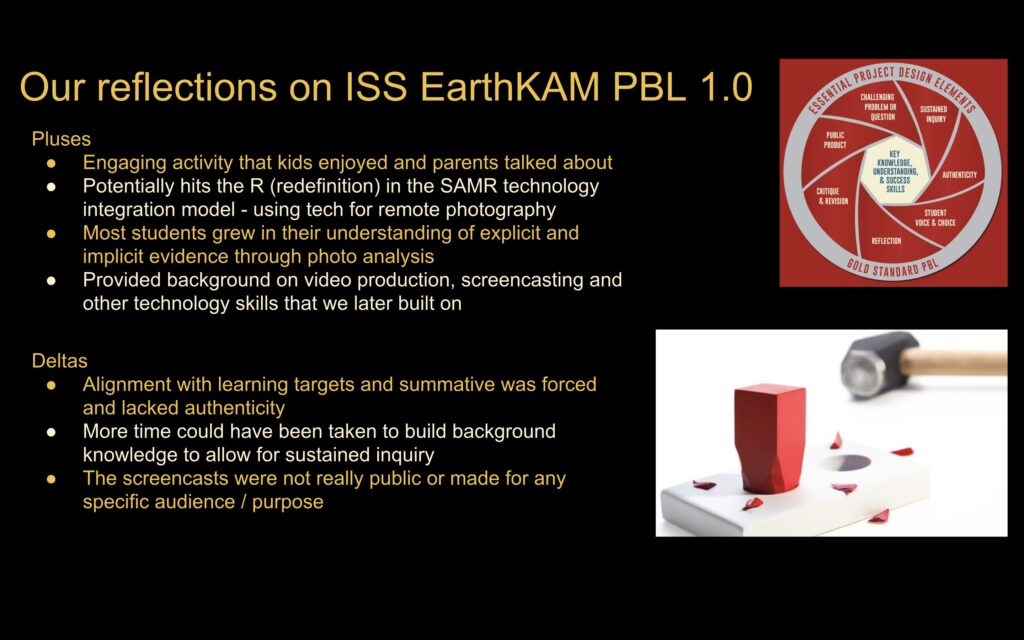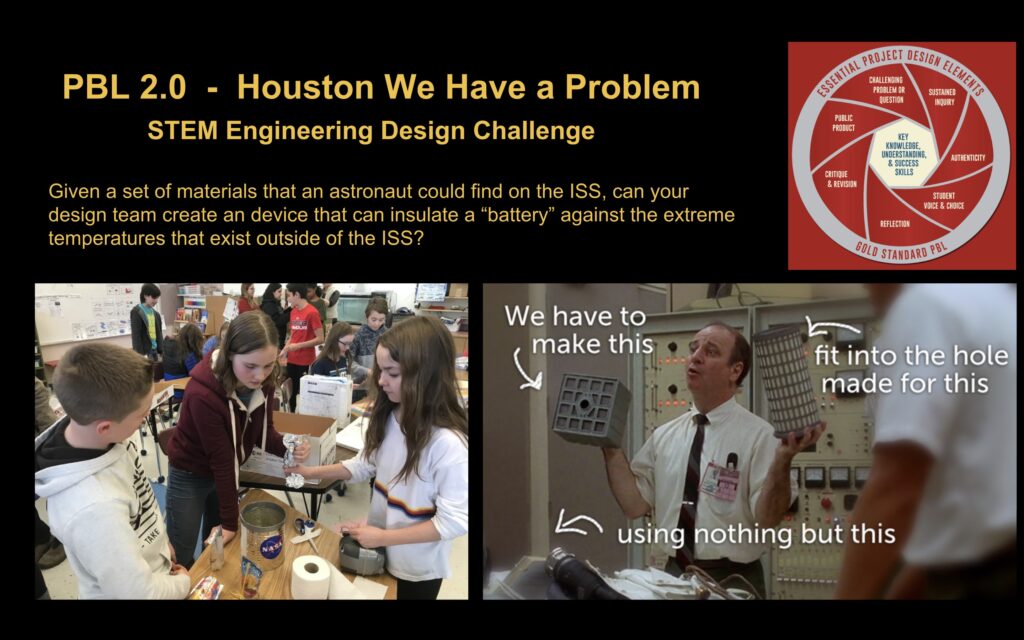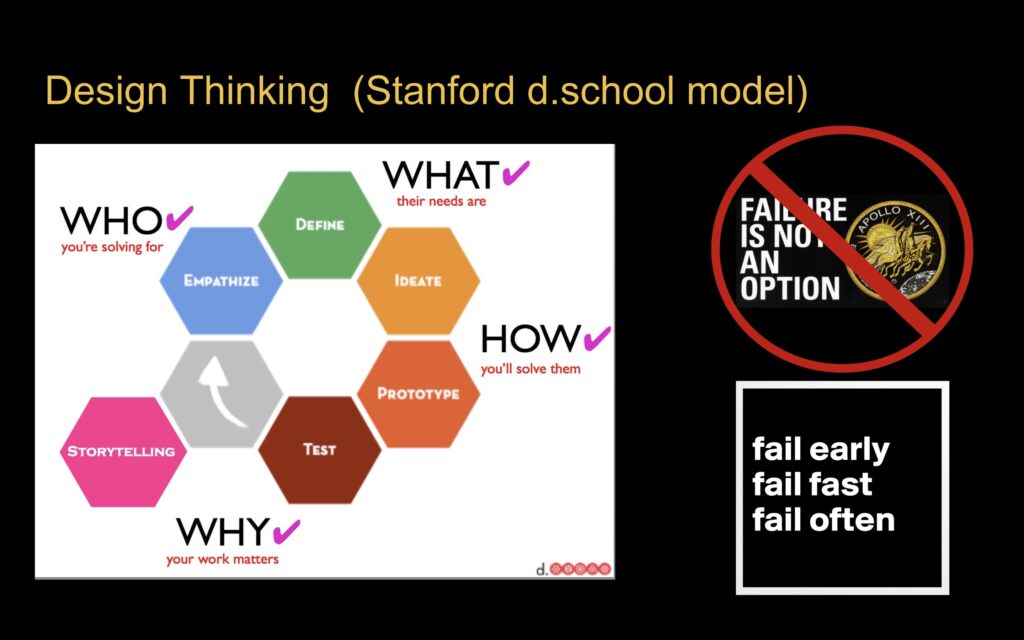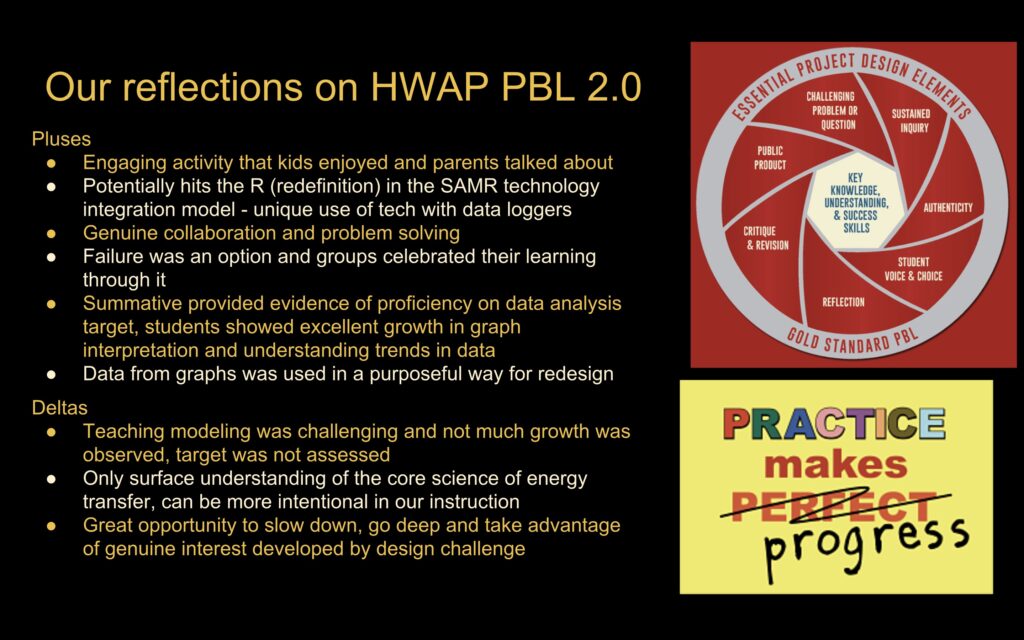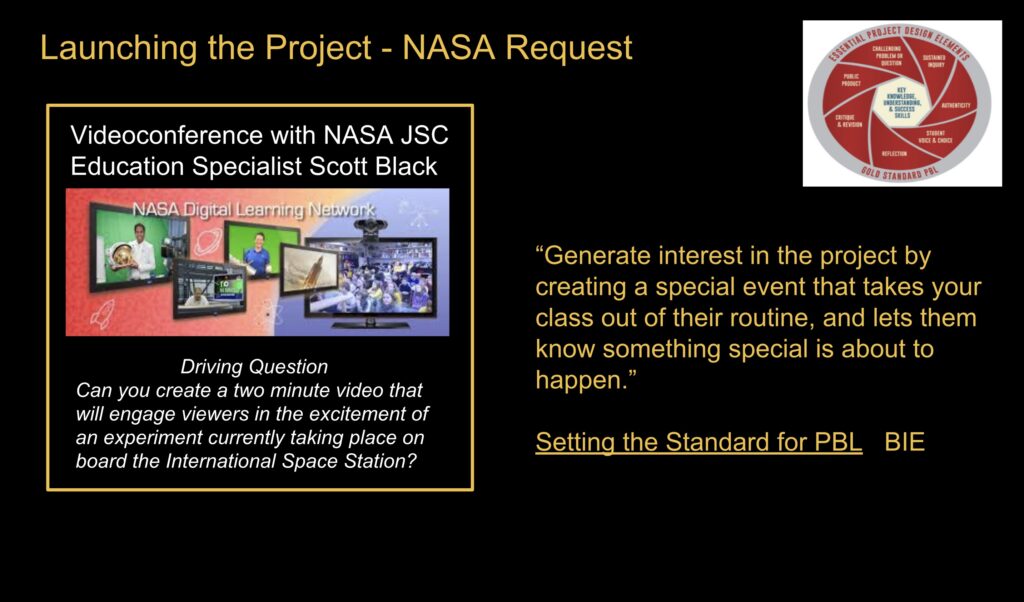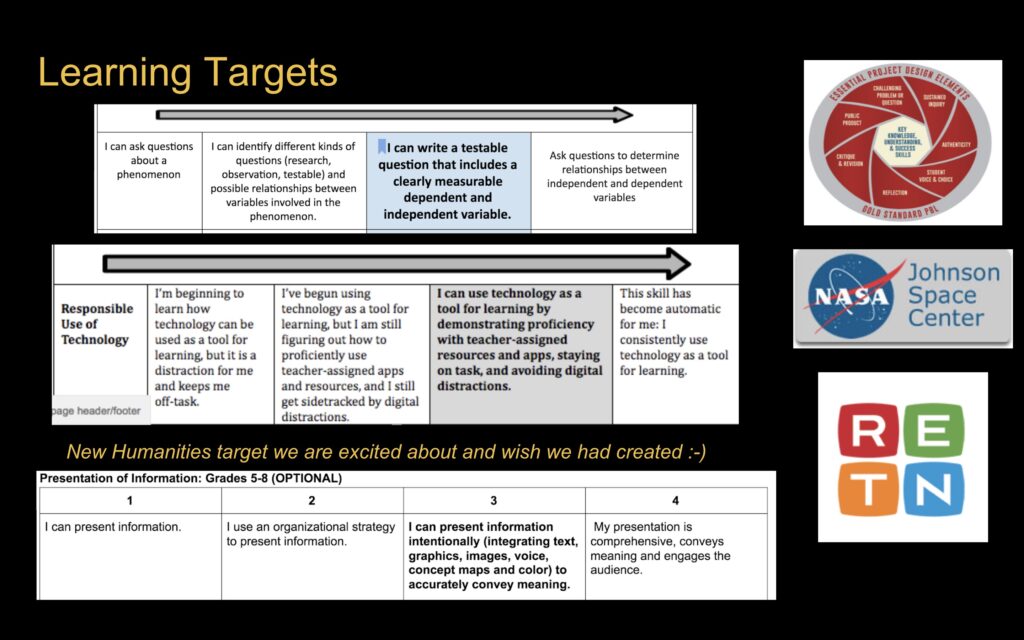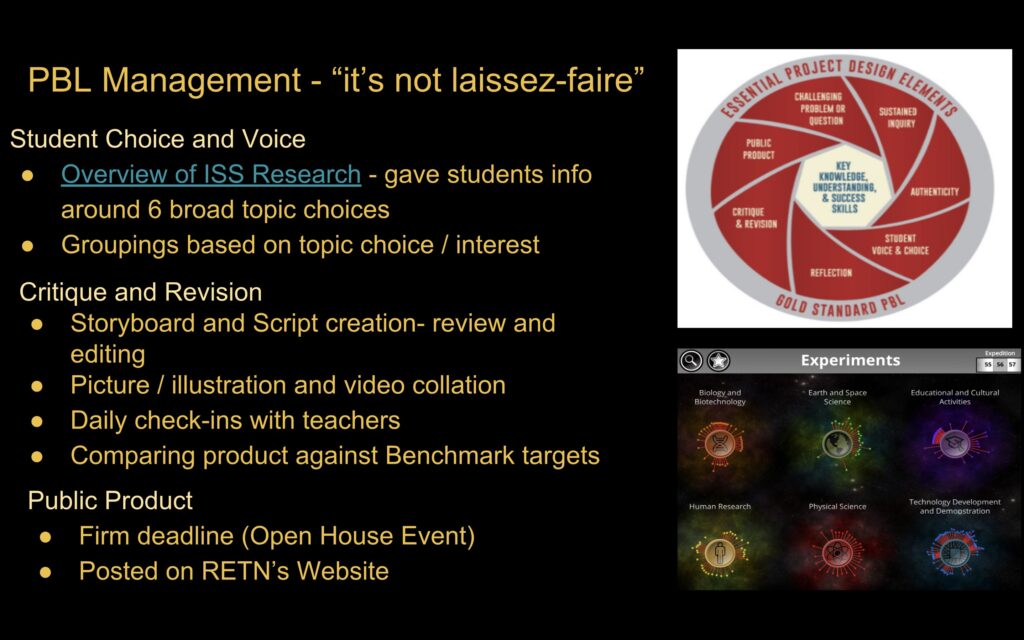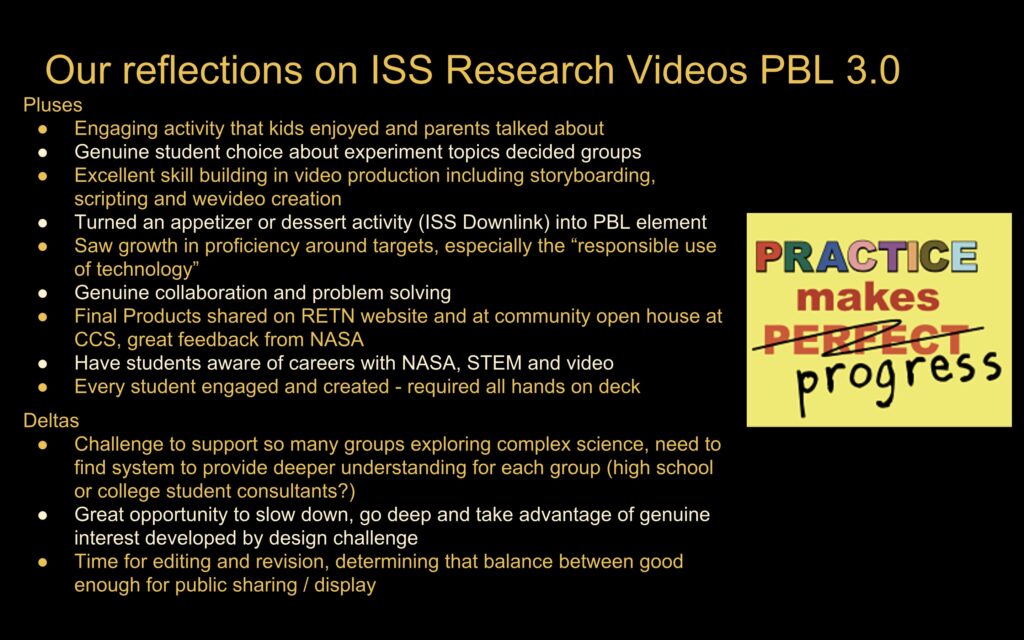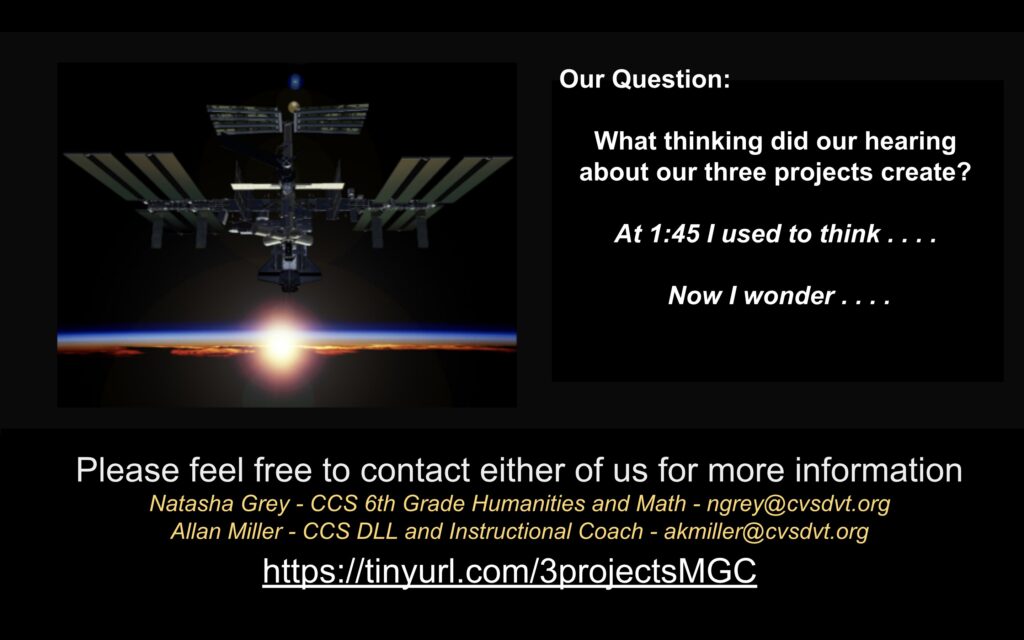“A Tale of Three Projects”
Two Vermont educators share how they measure success with project-based learning units… in space!
Allan Miller and Natasha Grey, two educators from Charlotte Central School, Charlotte VT, shared their journey towards authentic, meaningful, engaging project-based learning. The “Gold Standard” in project-based learning. At the 2019 Middle Grades Conference, they candidly talked about the successes and failures they experienced with three project-based learning units conducted during the 2017-2018 school year. The projects built towards a deeply meaningful and highly engaging set of learning opportunities. But along the way, there was a lot of learning on the teachers’ parts, in terms of what worked and what… could use some improvement.
So: how do you know what works?

A full, annotated transcript of their presentation, with slides, appears below.
Why We’re Here
“We were hoping to give you a brief overview of our experience planning a project-based learning experience for a group of sixth graders. We’ll start with our overall first experience and then talk about a model that we grounded ourselves in to help us figure out how to do project-based learning in a really meaningful way. Then we’ll talk about the next two iterations of our experience.
In case you’re wondering what the ISS is doing up there? 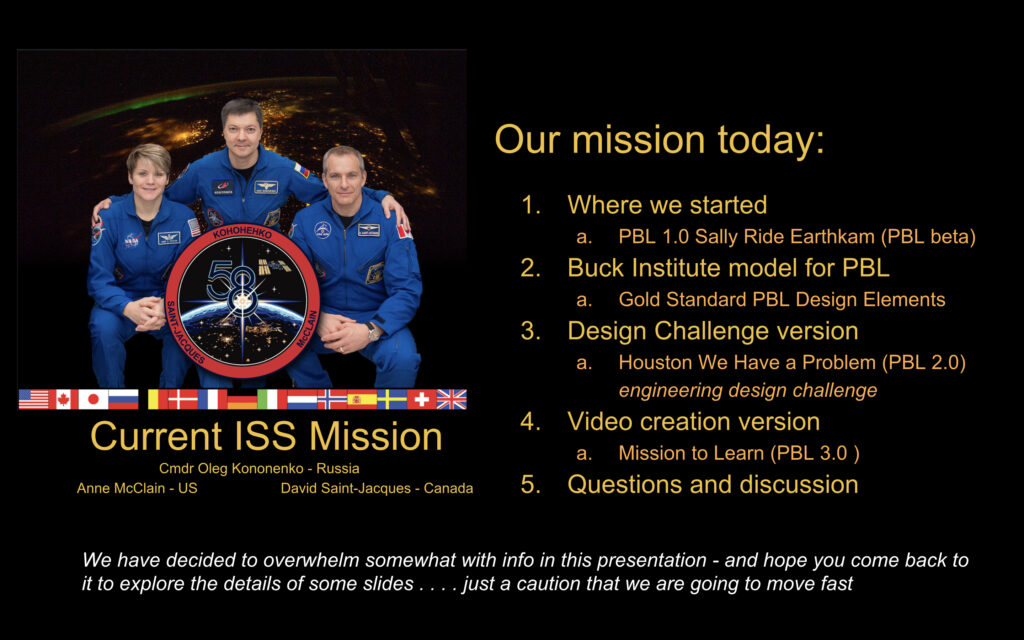
These are science-based projects but we’re not so much talking about the design of the project in science. We’re talking about the design of the project in general. Hopefully it transfers to humanities, language arts, science and math.
Dinner verses Dessert
Here’s our basic take away: this image represents our learning last year. 
The difference between having a super-engaging activity that students love and a scaffolded in, grounded project-based learning. That’s what we learned from our three projects. The Buck Institute, one of the world’s leading experts on project-based learning, refers to the difference between these two things as akin to the difference between dessert and a full course meal.”
Project 1.0 – Sally Ride EarthKAM
Natasha: ‘Allan came to me with a really awesome activity. One that he had done in several other schools and several other places. It was taking photographs from the International Space Station. I’ll be honest; I had no prior knowledge about the International Space Station. I had no interest in space exploration. It was a leap of faith for me. It turned out to be cool activity. Our school was in the process of implementing proficiency-based learning I was like “Oh we can use this, we can totally attach this to some learning targets and use it to integrate, and it’s going to be great.”’
Did we hit the targets? Well…
In implementing proficiency-based learning, we were trying to make the learning goals for students really transparent. As well as the pathway to how to get those goals. Trying to find different experiences for students to use to hit those targets was really important. We thought, well we have these really amazing pictures that students have taken from the International Space Station they can use those pictures as evidence. What a unique way to integrate evidence in a way that isn’t just text-based! It was also a really awesome opportunity for us to use our one-to-one Chromebooks and to develop some responsible technology skills. As well as some just really practical technology skills. We combined all of these wonderful ideas into a culminating project, that we thought would knock the socks off our students and us. Students needed to make a narrated PowerPoint using Screencastify , The students used their pictures as evidence to support a claim.
And here’s an example of the resulting screencast.
It was… not so great. In fact, we took that really awesome activity that kids were so stoked about and we forced them to make these miserable products. They didn’t like making them. And we had to pull teeth to get them to do it. They were absolutely horrible for me to sit down and watch *45* of.
We refer to this as a belly flop.
It’s like the dioramas that end up in the garbage after a project. What did we miss? This makes me go back and look and say, “Wow that had no authenticity, the students really didn’t have a choice, it wasn’t a sustained inquiry.” Let’s not kid ourselves, that wasn’t PBL. We learned and said, “Oh, maybe we’ve got to go back and do a little bit of analysis for ourselves of what project-based learning is.”
Reflections on PBL 1.0
There were some really great things. The kids loved doing the actual project; they were going home and taking photographs and really using a lot of great technology skills to do that. It was an innovative way to use chromebooks.
How often does a student get take control of the camera on an actual space station???? That is a whole lot more than using your Chromebook to write another essay.
A lot of students did show real growth on the evidence and analysis scales, especially between interpreting implicit evidence and explicit evidence. As well as really knowing the difference and being able to articulate it. But we wanted to build on video and screencasting. The tools showed us what the kids could do. It’s a formative assessment.
What didn’t work:
We learned one of the things that really didn’t work was: we forced that alignment between those targeted learning skills and that culminating project. It really was us forcing them. Background knowledge, that was another one. We had students do research they didn’t have background in — topography and the connection between civilizations — and that was forced. Plus, we didn’t give ourselves time for it.
Finally, those products weren’t really made for anyone except for us: their teachers. There was no genuine audience. Students really didn’t feel a deep connection to the work, or any real need to get it done. Or any need to do it well outside of pleasing us and that’s really not a good enough reason.
Project One? As the kids would say, “it was the worst of times”. But things did get better for us. (Eventually).
Project 2.0 – Houston We Have A Problem
We designed an engineering design problem. Continuing with the International Space Station theme was some background that we want to give the students. We looked at: “Can they make an insulator, can they take something like this which has some technology involved” and include data logger. Could they insulate this simulation battery and a) keep it cool in the heat extremes of space and b) keep it warm in the cold extremes of space. We were really intentional, we had a science target that we were working on teaching kids about and we had a math target. We started with what skills we wanted to build and then built this project around them.
A. Content in PBL? Why YES.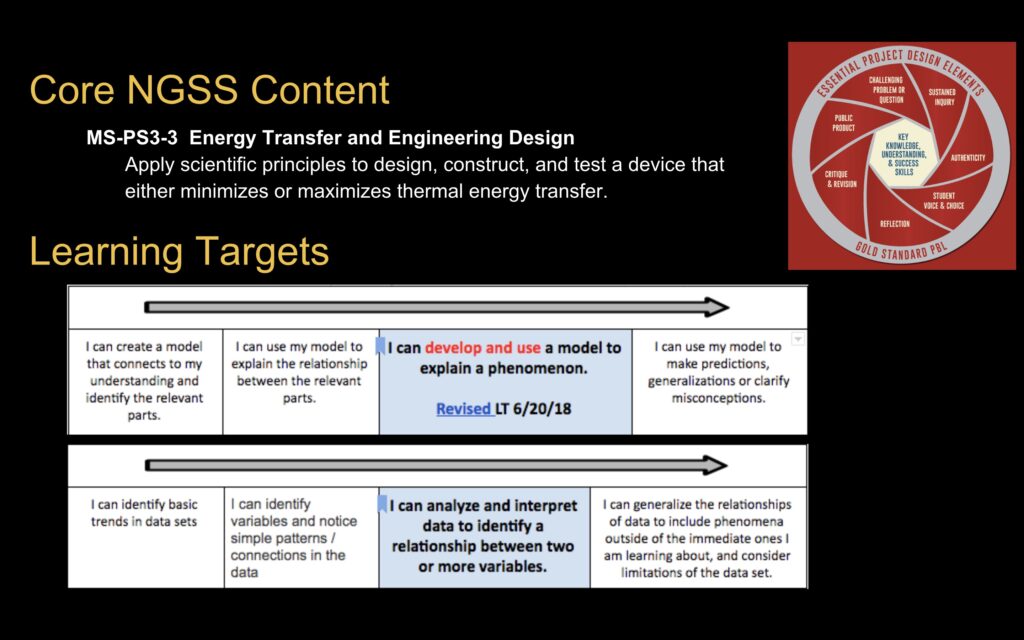
B. Fail early, fail often, fail fast
Now, we really have some belief in design thinking. Design thinking is the idea that we want students to learn to iterate and we literally introduced this as maybe the stupidest model that could ever be introduced in school. Failure is of course an option. We want the design thinking idea that even the best engineers fail early, fail often and fail fast, that’s how they learn. We follow this model to say, “You’re going to test, you’re going to prototype and it’s not whether your design is fantastic, it’s what you learn from your design”. That’s what scientists do!
So, this is kind of how the project worked. We had a set of materials that we could generally say an astronaut could find on the International Space Station. Working in groups gave them some very specific parameters.
C. Test, examine, rethink
From that, here are our first round products. Here are the insulators that we designed to withstand heat.
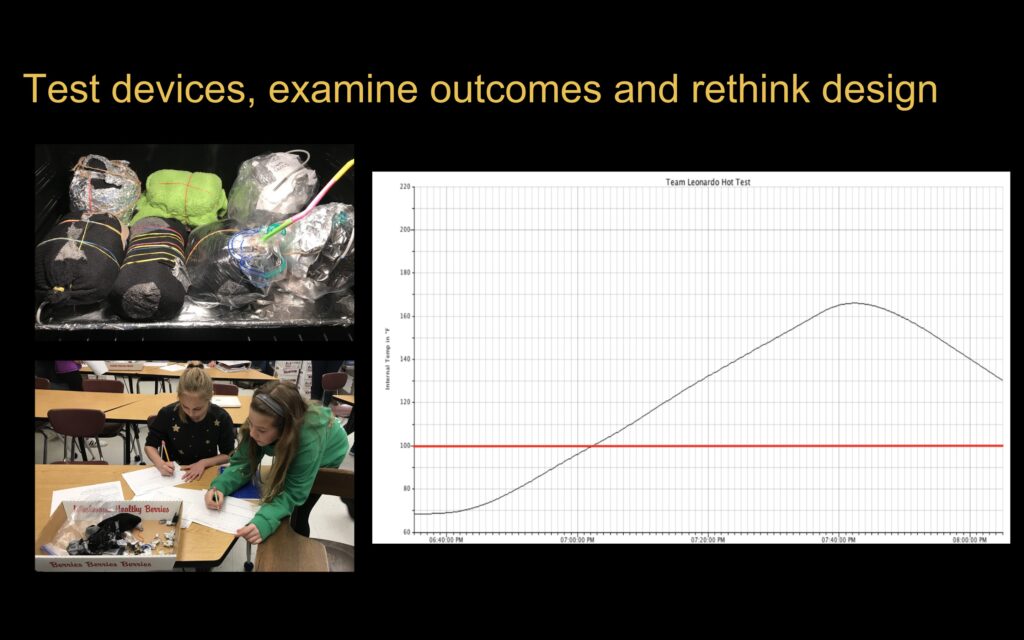
By the way, Allan’s wife was incredibly generous and let him put those insulators in the oven at home. When you put a plastic bag in the oven it doesn’t smell good. It melts. And students learned it’s not especially an effective insulator. However, from that experience, each team received a graph full of data. And they were so invested in understanding these graphs and understanding how they related to the model that they had designed. And we had never seen kids dig that deeply into understanding the graph, it was amazing. So right there was our Math target:
Can you understand that data and what it means?
D. Next: collaborate and redesign
The next thing they had to do was after they worked in their small groups to understand their design and what elements worked in it, they had to collaborate with the opposite groups. Suddenly they were on new teams that had to deal with the heat and cold. They had to work with brand new collaborators in designing an insulator that could withstand both heat and cold. And they dug right in. We have just never seen sixth graders collaborate so genuinely over an academic subject as they did with this design challenge.They were all invested in understanding each other’s designs, and designing something that could really hit those targets that Allan had laid out for them. Here is one of the models that they created so that their insulator could be recreated by someone else, and you can see real evidence of that collaborative learning.
E. Growth thanks to data.
Now, whereas the Trial One designs were all over the place, by the time we’d gotten down to our Trial Two designs, students had really identified elements using the data from the graphs. They looked at their original designs and identified elements that helped prevent that heat transfer. They used:
- their Trial One models;
- Trial One graphs;
- their new teams;
- their Trial Two Models;
- and their Trial Two graphs
to decide which device was most successful, which insulator was most successful.
Reflections on PBL 2.0
“Practice makes progress”
You can see, we were definitely growing in our knowledge of proficiency-based learning and project based-learning. Again, this was a really engaging activity that kids and parents were talking about. That was really important to us. Also just the graphing component, digital graphing, that was something new for most of them. This was really genuine problem solving and collaboration in a really meaningful way. Truly, we learned as much from these failures as we did these successes. We thought we really hit the design elements of it. Teams realized that this failure informed the learning, which is what we wanted hear from the engineers who designed it.
Our end result, that summative, really showed their growth. We could use that as a summative assessment, when they had to examine those graphs and identify which insulator was the most efficient and was the best. That was real evidence for us of their understanding, it wasn’t just observational like it was in the first round of project based learning.
The data was relevant. It was authentic and informative thinking. So moving forward they had something they wanted that sustained inquiry.
Notice we have a lot more pluses this time. One our deltas was that teaching and modeling was really challenging and models really didn’t show a lot of growth from the beginning to the end. They were really basic. We decided not to even asses the modeling target.
Students understood how to make a better design
If we go back to our core energy transfer, again, students understood how to make a better design. They understand conduction, convection, reflection. Both concepts we could have gone much deeper in so that they were intentional could explain this is why this model worked and works better than this one. Didn’t get that as well as we’d like to.
It was a great opportunity to slow down and do those things. We didn’t take the time to do that, next time we might do it. We might really dig deep into those concepts.
PBL 3.0: ISS downlink and research videos
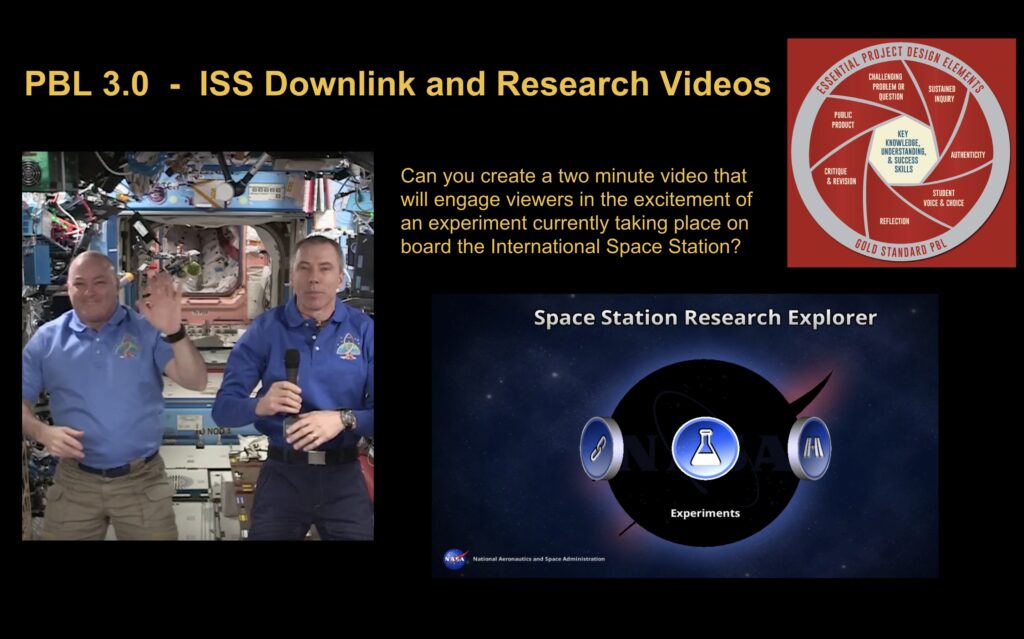
We were presented with an opportunity based off of some work that Allan did to have a downlink conversation with astronauts who were actually on the International Space Station. WHAT? It was a really powerful experience.
Now, this is not an opportunity available to any school in the country; they only do about five or six a year and you apply for it. But there’s also the opportunity through NASA to Skype an astronaut. NASA pretty much guarantees if you give them five or six weeks, they’ll hook you up with genuine astronaut you can Skype in your classroom, which is one of those just motivating things.
We learned from our Earth Cam experience (PBL 1.0, above) that even though it was a really cool activity, if we didn’tembed it in a meaningful way… that’s all it was going to be. We worked really hard to create something that would make this downlink really meaningful. And we came up with a challenge: Can you create a two minute video that engages viewers in the excitement of an experiment that’s taking place on ISS? That’s what the kids were meant to do after.
Launching the project with a NASA REQUEST!
We needed a really special launch. To help motivate our kids and get them really deeply invested. We knew we had to do something a little different ,and so we tapped into a existing resource: NASA education specialist, Scott Black. It really didn’t take all that much planning, it took about 20 minutes. He Skyped in, did a video conference with our students and asked them the question:
“Can you guys create a video? Can you help NASA out and create this video for us?”
Oh boy. Our kids walked away saying, “NASA needs us! So we’re there!”
Learning targets 3.0
Again, we wanted to be really intentional about our design and not just have this be a really cool activity but how to be grounded in a learning that we wanted them to be doing. Understanding testable questions in science, using that technology responsibly. Then there’s a humanities target too.
PBL Management – “it’s not laissez-faire”
We set this wonderful project up, and then we couldn’t just step back and not do anything. There was a lot of teacher management that went into it. There was a lot of student-directed learning. The students had lot of choice. They had a lot of choice in this project. But Allan and I grouped them really intentionally to have supportive peer relationships. They had to do a lot of critiquing and a lot of revising to make sure that it was a worthy product.
Allan and I set up a lot of opportunities and a lot of touch points for them. Sometimes it was peer-to-peer, and sometimes it was peer-to-teacher, and sometimes it was just check-pointing against some of those standards, some of those scales.
We helped our students manage their time because these were genuine public products that they were going to present at open house. It really was a driver for our students.
Seemingly, a little different than our product from the first one. Pretty excited about those –there are 20 of them. Let’s just say we’re excited.
Reflection on PBL 3.0
Again they loved it, the parents loved it, we loved it. It was so much fun to do. We had the voice, the choice.They really built skills in a genuine way, and asked wonderful questions. I think we turned something that could have been just a dessert or appetizer downlink into a project that had genuine learning with it. We saw growth in all the targets that we had set out in this project and that was because of our intentionality around how we built it.
Especially the collaboration and the ability to solve problems. Those public products got so much feedback and the kids were so proud of that and so invested in them. We have a lot of students who are now talking about career options; I could do something with this.
Next steps: Keep talking with scientists
As we think about it this year our big challenge is to go deep in the science. We couldn’t have the in-depth conversation we wanted but we did discover that, there’s another program, “Skype with a Scientist”. With about two to three weeks warning you could identify a scientist in the life sciences and connect with them. That’s what we’re going to do. We will take each individual group, they can connect with them. Have one on one conversations saying “this is what I think, I don’t understand this” We’re going to try to leverage that technology in that way.
I’d really take that opportunity to slow down, go deep into learning and take advantage of their genuine interest.



